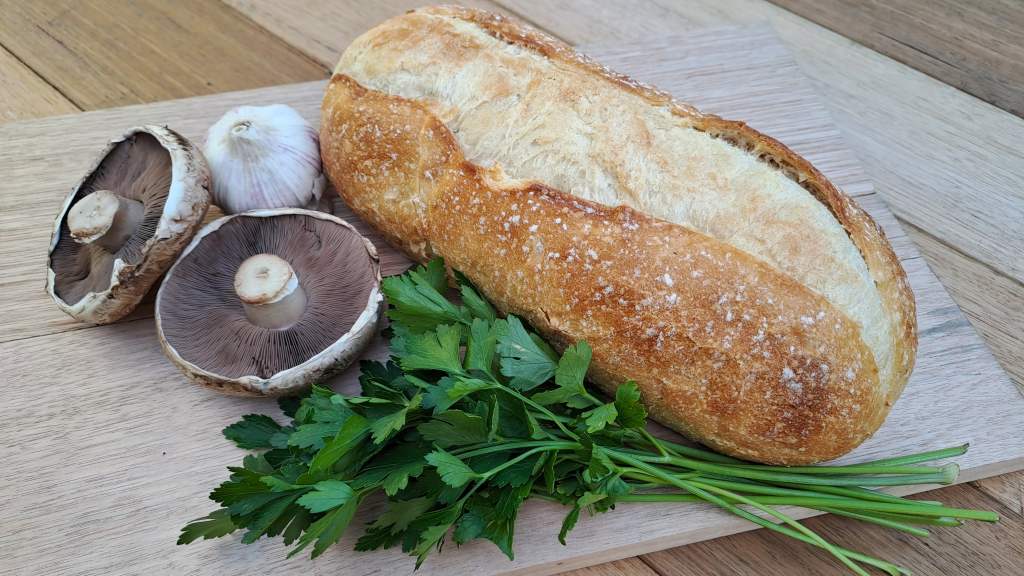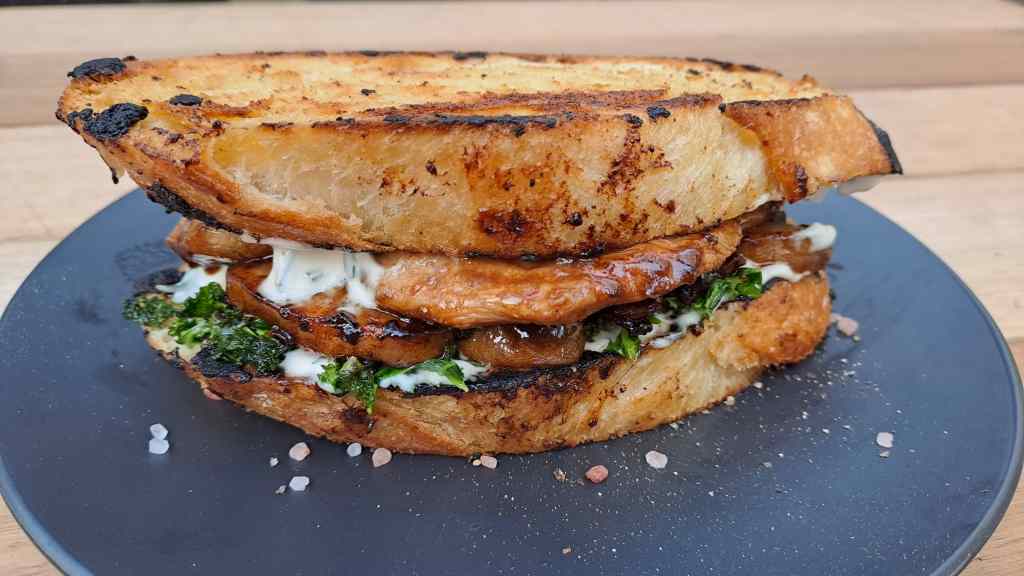With the current price of groceries, a trip to the supermarket can be a near vomit-inducing experience. If you’re like me, you might wish that you could travel back to “simpler” times, like the Middle Ages… or 2019. You may even wish you could escape to a complete fantasyland, like the ones you explore in games.
My game of choice is The Witcher 3, but for better or worse, this fantasy will never become a reality. Instead, I’ve found the next best thing to help me imagine that I’m there: The Witcher Official Cookbook. It contains 80 recipes from The Witcher series and the first one in the book immediately caught my attention.
The Witcher 3 chicken sandwich is somewhat of an icon on the Continent, as far as consumables go. Costing 30 crowns from an innkeeper – or commonly found in the pockets of slain bandits – this poultry panini consists of rustic bread, stout-marinated chicken, grilled mushrooms, kale and creamy sauce. It sounds delicious.
But with the aforementioned cost of living crisis, how economically viable is the Witcher 3 chicken sandwich in 2024? Can you afford to get carried away roleplaying as the innkeeper at Cunny of the Goose? And is it even worth your money? Let’s make it and find out.
Table of Contents
The grocery list
The Witcher 3 chicken sandwich has a surprisingly detailed recipe, as far as sandwiches go, so maybe don’t attempt it on a busy weekday evening. The ingredient list is detailed in full within The Official Witcher 3 Cookbook, and listed on the Witcher Kitchen. With four servings due to be plated up, this was the shopping list:
- Guinness Draught Stout can – 440mL
- MasterFoods Hot English Mustard – 175g
- A lemon
- A loose garlic bulb
- Sea salt grinder – 100g
- Honey squeeze bottle – 375mL
- 2 chicken breast fillets – 500g
- Whole egg mayonnaise – 450g
- Sour cream – 300g
- A fresh parsley bunch
- Black pepper grinder – 50g
- A fresh kale bunch
- Vegetable oil – 750mL
- Unsalted butter – 250g
- Loose flat mushrooms – 100g
- Pane di casa loaf

Read: To Gwentfinity and Beyond: The democratic future of The Witcher card game
The methodology
There are two ways to look at this: how much it costs to buy all of the ingredients to make the recipe, and how much it costs for the exact quantities of the ingredients that you’re using. We’ll look at both for the sake of the argument.
For an accurate price estimate, we’re examining prices from the three biggest supermarket chains in Australia: Coles, Woolworths and Aldi. To level the playing field, this analysis assumes that you have none of the ingredients (you’re not using salt or oil that’s already in your pantry), that nothing is discounted and that the items purchased should be of comparable size and quality across retailers.
With those factors in mind, I’ve chosen the items with the lowest price while being the closest match to what the recipe calls for. Prices are displayed in Australian Dollars and are accurate for Melbourne stores at the time of publication. Finally, because this recipe covers four servings, we’ll be dividing the total costs into four later.
The shopping trip
As of February 2024, if you were to purchase every ingredient on the list, it would set you back somewhere around the $60 mark. That’s regardless of where you shop, with the totals coming to $60.13 at Coles, $58.11 at Woolworths and $60.71 at Aldi.
The biggest expense by far is the can of Guinness, costing $8 at Coles Liquorland and $6.90 at Woolworths BWS. The lowest across the board is the fresh ingredients that are able to be purchased individually or by weight, such as the lemon, garlic and mushrooms, costing less than $1.80 each.
Interestingly though, the fresh ingredients are also the category that cause issues with Aldi’s reputation as the cheaper supermarket. Most ingredients are slightly cheaper there. Garlic was $24.99 per kilogram rather than $28 at the competitors. A pane di casa loaf was $3.99 rather than $5.
Jar ingredients like salt, pepper, mustard and honey were $0.20 to $0.40 cheaper each. But Aldi’s lack of a deli, a tendency towards bulk sizing and a more limited range of loose vegetables mean that you have to purchase pre-packaged ingredients, leaving you with a much higher quantity than you actually need.
Working with the average we’ve established here, you’re looking at $60 to buy the ingredients for four sandwiches – approximately $15 per sandwich – with some to spare afterwards. That’s a significant sum for one recipe, especially when you consider that the average Australian household spends $160 per week on groceries.
You could easily shave $15-20 off the total if you’ve already got basic ingredients like salt, pepper, butter, oil, honey and mayonnaise, of course, but it’s still not the most economical home-cooked meal.
The price breakdown
Next, we can calculate the percentage of each item used in the recipe and determine the exact cost. The majority cost less than $0.50, because you only use a small amount, excepting the bread and chicken where you use it all. In doing so, you’re looking at a number closer to the $20 mark, with the totals coming to $20.17 at Coles, $19.50 at Woolworths and $19.14 at Aldi.
It appears that Geralt’s famous sentiment applies to supermarkets too: “evil is evil … lesser, greater, middling, it’s all the same”.
Alas, at just $5 per serving when you strip it back to these exact measurements, it’s definitely cheaper than eating at a restaurant – if you don’t count the time and effort you put into cooking for yourself. This isn’t entirely realistic because you can rarely ever buy just the amount you need of an ingredient, but I’ll let you decide which answer you think is correct in this highly serious equation.

Is the Witcher 3 chicken sandwich worth it?
Now that we’ve done all the tedious numerical work, and felt rightfully disgusted at the illusion of choice when it comes to supermarkets, there’s only one factor remaining: will the Witcher 3 chicken sandwich really transport you to another world?
In short, yes. It is one fancy sandwich. It took me two hours to prepare, and it was a labour of love. The final product doesn’t boast the same regenerative properties as the in-game equivalent, but it is satisfying to make.
Appearance wise, the Witcher 3 chicken sandwich looks precisely how you’d imagine it to when an innkeeper brings it to your table with a flagon full of ale. As for the taste, for the first half of the sandwich, I was in heaven. Around the halfway point I began to realise that it was very rich and very salty – because almost everything, including the kale, is fried in oil or butter and coated in salt – so I struggled through the rest.
If anything, this just seems to support the idea that the cookbook’s authors, Anita Sarna and Karolina Krupecka of Nerds’ Kitchen and Witcher Kitchen, meticulously-researched each recipe.
Of course bandits would enjoy a sandwich dripping with sauce and fat after a hard day’s work harassing passersby – though I can’t imagine where they’d source mayonnaise or how they’d stop it from going rancid in their pockets…
Even if I don’t make the Witcher 3 chicken sandwich again, I’m still glad to have an official resource on the food from my favourite game. The book itself is a high-quality hardback, making it a gorgeous display piece to add to my bookshelf – ahem, Witcher shrine – and I’ve still got another 79 recipes to try.
A copy of The Witcher Official Cookbook was purchased for the purpose of this article.





